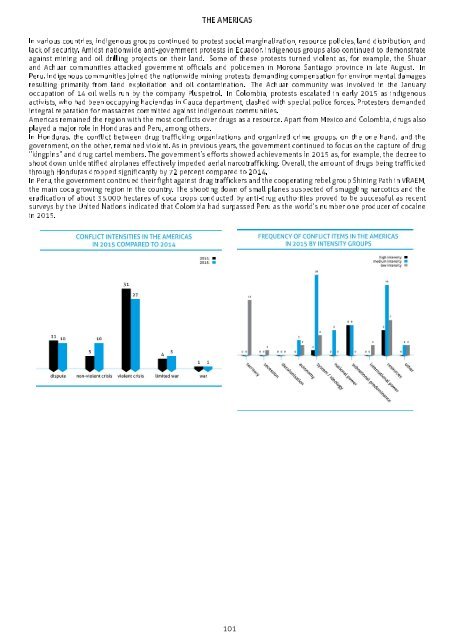ConflictBarometer_2015
ConflictBarometer_2015
ConflictBarometer_2015
Create successful ePaper yourself
Turn your PDF publications into a flip-book with our unique Google optimized e-Paper software.
THE AMERICAS<br />
In various countries, indigenous groups continued to protest social marginalization, resource policies, land distribution, and<br />
lack of security. Amidst nationwide anti-government protests in Ecuador, indigenous groups also continued to demonstrate<br />
against mining and oil drilling projects on their land. Some of these protests turned violent as, for example, the Shuar<br />
and Achuar communities attacked government officials and policemen in Morona Santiago province in late August. In<br />
Peru, indigenous communities joined the nationwide mining protests demanding compensation for environmental damages<br />
resulting primarily from land exploitation and oil contamination. The Achuar community was involved in the January<br />
occupation of 14 oil wells run by the company Pluspetrol. In Colombia, protests escalated in early <strong>2015</strong> as indigenous<br />
activists, who had been occupying haciendas in Cauca department, clashed with special police forces. Protesters demanded<br />
integral reparation for massacres committed against indigenous communities.<br />
Americas remained the region with the most conflicts over drugs as a resource. Apart from Mexico and Colombia, drugs also<br />
played a major role in Honduras and Peru, among others.<br />
In Honduras, the conflict between drug trafficking organizations and organized crime groups, on the one hand, and the<br />
government, on the other, remained violent. As in previous years, the government continued to focus on the capture of drug<br />
''kingpins and drug cartel members. The government's efforts showed achievements in <strong>2015</strong> as, for example, the decree to<br />
shoot down unidentified airplanes effectively impeded aerial narcotrafficking. Overall, the amount of drugs being trafficked<br />
through Honduras dropped significantly by 72 percent compared to 2014.<br />
In Peru, the government continued their fight against drug traffickers and the cooperating rebel group Shining Path in VRAEM,<br />
the main coca growing region in the country. The shooting down of small planes suspected of smuggling narcotics and the<br />
eradication of about 35,000 hectares of coca crops conducted by anti-drug authorities proved to be successful as recent<br />
surveys by the United Nations indicated that Colombia had surpassed Peru as the world's number one producer of cocaine<br />
in <strong>2015</strong>.<br />
101


